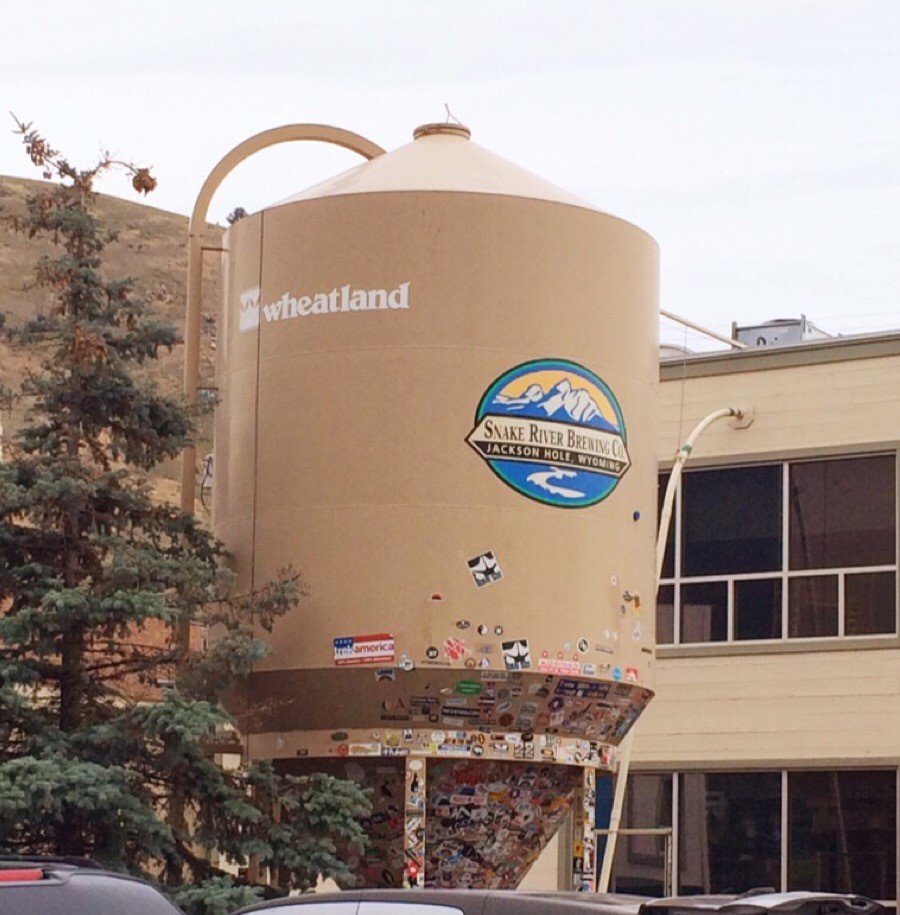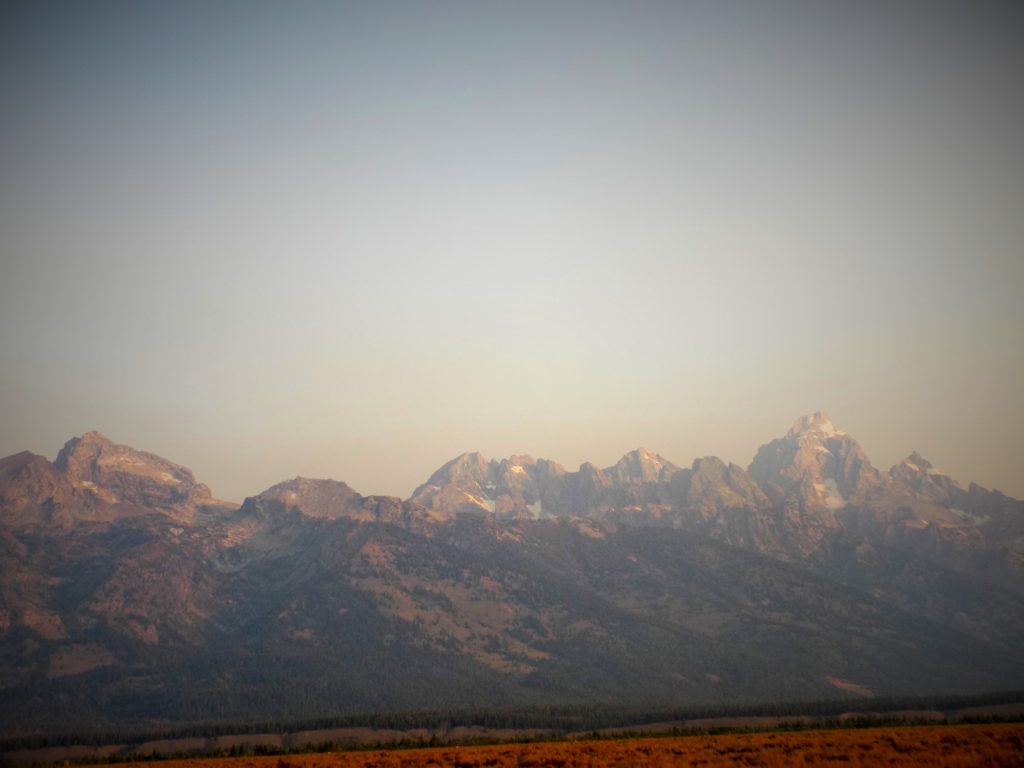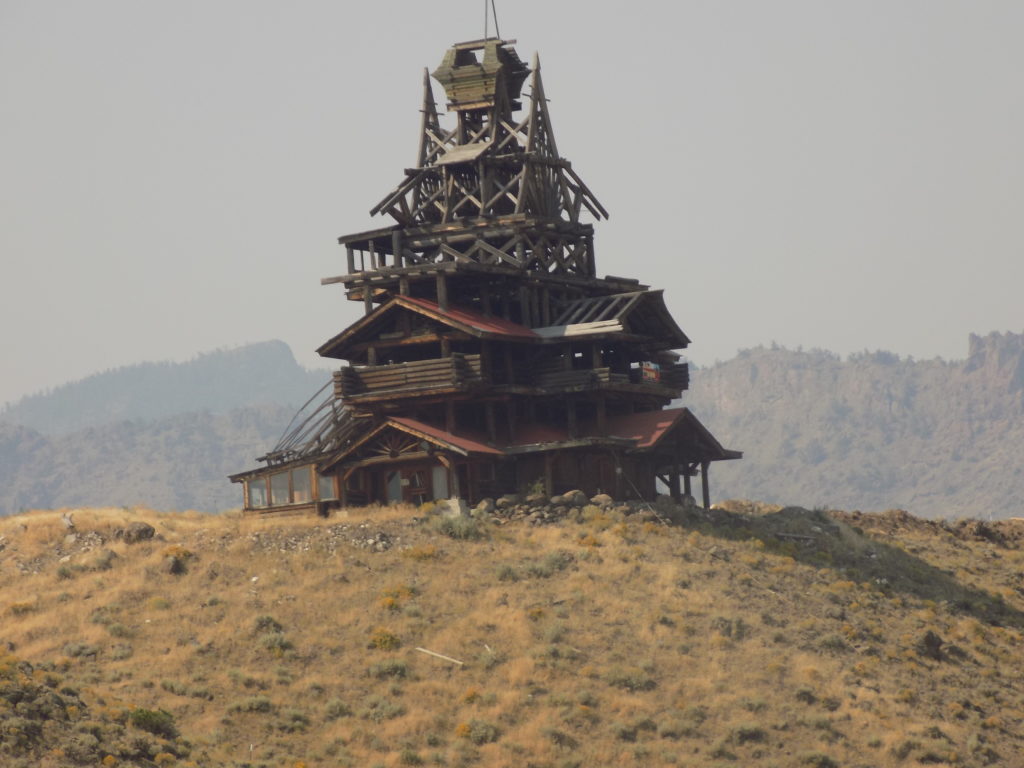I arrived in Jackson late in the afternoon of 2 September and, as you saw in the photos I posted previously, while my first views of the Tetons were impressive, they were breathtaking mainly because the ash laden air complicated everyone’s breathing. I drove into town, checked into the hotel, and took a nice three-quarter mile walk back to the Visitor’s Center (which I’d passed on my way into town) where I expected to get information about hikes in the park and hoped to get predictions of Sunday’s anticipated weather and, more importantly, air quality. The first two were helpful. The last wasn’t hopeful.
I was in something of a buoyant mood because I’d learned that earlier in the day, Maryland had gone into Texas and surprised the NCAA football and gambling world by upsetting the Longhorns 51-41. Convinced that a celebratory libation was called for, I strolled over to the Snake River Brew Pub. There wasn’t a table available, so I sat at the bar where I tried their Szechuan Wings accompanied by an Eclipse Ale.
Like any good brew pub, the televisions scattered about the place were all tuned to various sporting events – mostly more NCAA football.┬Ā Several screens were showing the featured game of the night – Alabama versus Florida State. A woman was sitting behind me who, though the chap she was with was rather quiet, was vocal enough in her support for Alabama that the entire bar knew it. A few seats to my right at the bar sat a fellow who was an ardent Penn State fan and the pair had a few mildly testy exchanges about the relative merits of the two programs.
When the opportunity presented itself, I turned and quietly told her that I admired her restraint for not saying anything about Penn State, its horrific scandal, and its seemingly irrational fan base particularly in that regard. The woman and her friend (and I have now forgotten their names) invited me to their table and, as we talked football, they bought me a Jenny Lake Lager. This beer had a nice, clean start and a milder finish than the ale I’d had with my wings and was a bit more bitter than is my preference. (That’s not to say I hadn’t finished it. It was celebratory, after all.)
A shrine to love, obsession and spite (or so the urban legend goes).
While the afternoon temperatures throughout the trip had been mild to warm, by the time September turned and I reached the 6,000 feet plus altitude of Jackson, the nights were growing chilly. I set out early on the dewy morning and in the few minutes I needed to leave town, I was immediately greeted by another pale blue-gray ashy morning sky.
Also, when I woke Sunday morning, the pain in my ankle had flared for some unknown reason and thinking that this, together with the poor air quality would complicate any hiking I’d hoped to do, I decided to make the four hour drive through both Grand Teton and Yellowstone National Parks to the eastern outskirts of Cody to visit Heart Mountain while holding onto the hope that the skies might clear and the little blue pill would Aleve-iate my ankle discomfort later in the day. In truth, in these conditions all of the views were falling short of my expectations and that, too, tamped down my motivation to explore the park. I should note that the stop at Heart Mountain had been on my agenda from the outset and wasn’t part of a plan “B”. Visiting on Sunday rather than Monday was the ash induced itinerary change.
In making the drive, however, thanks to Roadside America, I knew I’d pass the Smith Mansion on the west side of Cody. HereŌĆÖs its story.
Sometime in the late nineteen seventies, a local Cody resident and architect / engineer named Francis Lee Smith began building what he hoped would be a family cabin home for himself, his wife and their children. It didnŌĆÖt quite end up that way.
Smith began digging and excavating for the house in 1971 – a process that required three men and two years. The next step entailed collecting lumber, which Smith did by driving his half-ton pickup truck to Rattlesnake Mountain about 15 miles from the site. Although the mountain is part of the Shoshone National Forest, the Forest Service allowed individuals to freely remove burnt timber from a wildfire that had ravaged the mountain in 1952 on the proviso that they haul it themselves. It’s reported that Smith hauled out five or six logs per day.
Despite its lack of a roof or any plumbing, Smith began living in the house as it slowly took shape and often brought his children to stay with him. His daughter Sunny Larsen recalls spending nights in sleeping bags, roll outs or elaborately crafted wooden hammocks and swings. In one story I read, Larsen said of her father, “He was very eccentric.┬ĀOne day I came home from school and he had collected moose droppings and put them in a basket in the window.”
She also described having a raccoon move into the house while they stayed there and having to use a five-gallon bucket outside if they needed to go to the toilet in the middle of the night. “All you ever had were the stars over your head. It didn’t matter if there was four feet of snow, we toughed it out alone,” Larsen said.
Many reports say that Smith became so obsessed with building the house and having the family live under those conditions that it led to his divorce in 1980. Larsen says that her mother was the one true love of her father’s life and that after the divorce he became even more obsessed with the house. And here’s where the legend enters the story. (I call it a legend because I’m not able to independently verify it.)
According to several people I talked with (one of whom might have been Sandy way back in Douglas) one of the terms of the divorce settlement was that, once complete, ownership of the house would pass to his ex-wife. Thus, whether driven by an obsessive love or by spite, Smith decided to never complete the house.┬ĀThe story reached something of a tragic climax
when, in 1992, at the age of 48, Francis Lee Smith was working on the structure without any sort of tether as he often did. As anyone who has visited the Wyoming prairie knows, it’s a high wind area. A gust of wind came along knocking Smith from his perch. He landed so awkwardly that the 12-foot fall killed him. The structure remains unfinished though Larsen started a foundation in 2009 in an attempt to preserve and restore it.
Today, driving along U S Route 20 through the Wapiti Valley between Cody and Yellowstone Park’s East Entrance, the Smith Mansion stands nearly 75 feet tall in decaying “glory.”


